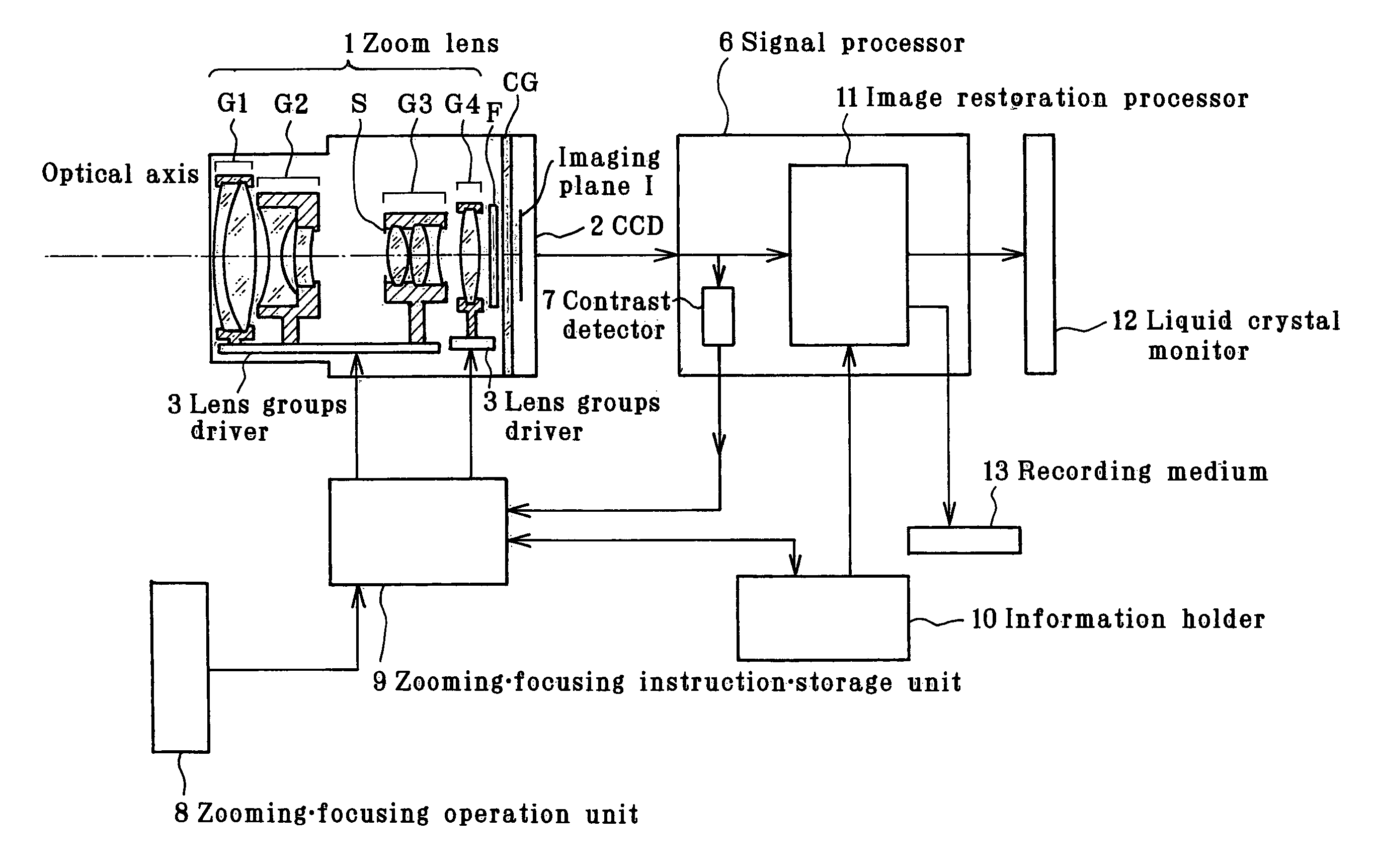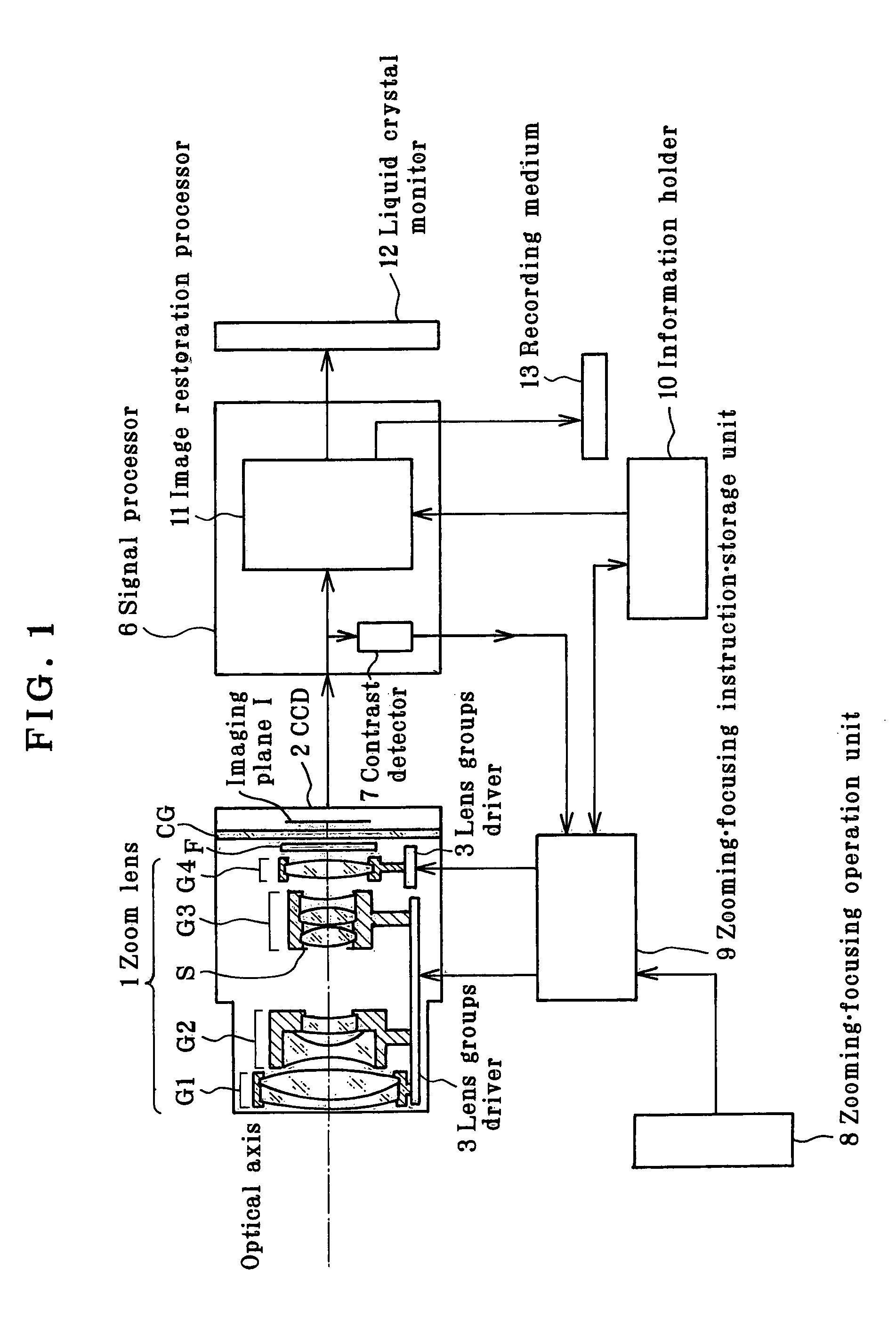Imaging apparatus adapted to implement electrical image restoration processing
a technology of electrical image and restoration processing, applied in the field of imaging equipment, can solve the problems of poor image quality, more blurred images taken by imaging devices, and bulky optical systems, and achieve the effects of reducing the size of the apparatus, good image quality, and effective us
- Summary
- Abstract
- Description
- Claims
- Application Information
AI Technical Summary
Benefits of technology
Problems solved by technology
Method used
Image
Examples
example 1
[0234]
r1 = 13.941d1 = 0.80nd1 = 1.92286νd1 = 20.88r2 = 10.260d2 = 3.33nd2 = 1.58233νd2 = 59.40r3 = −45.370 (Aspheric)d3 = (Variable)r4 = −13.175 (Aspheric)d4 = 0.90nd3 = 1.83481νd3 = 42.71r5 = 4.180 (Aspheric)d5 = 0.80r6 = 5.674d6 = 2.07nd4 = 1.94595νd4 = 17.98r7 = 9.459d7 = (Variable)r8 = ∞ (Stop)d8 = 0.00r9 = 4.390 (Aspheric)d9 = 1.60nd5 = 1.51573νd5 = 64.10r10 = −10.248 (Aspheric)d10 = 0.10r11 = 7.016d11 = 2.00nd6 = 1.77250νd6 = 49.60r12 = −4.424d12 = 0.40nd7 = 1.74950νd7 = 35.28r13 = 3.071d13 =(Variable)r14 = 27.505 (Aspheric)d14 = 1.87nd8 = 1.74330νd8 = 49.33r15 = −21.289d15 =(Variable)r16 = ∞d16 = 0.50nd9 = 1.51633νd9 = 64.14r17 = ∞d17 = 0.50r18 = ∞d18 = 0.50nd10 = 1.51633νd10 = 64.14r19 = ∞d19 = 0.36r20 = ∞ (Imaging plane)Aspherical Coefficients3rd surfaceK = 0.000A4 = 4.12725 × 10−5A6 = 6.93194 × 10−8A8 = −5.03992 × 10−9A10 = 4.54452 × 10−114th surfaceK = 0.232A4 = 3.06592 × 10−4A6 = 2.98441 × 10−5A8 = −1.52860 × 10−6A10 = 2.61101 × 10−85th surfaceK = −0.394A4 = −3.82320 × 1...
example 2
[0235]
r1 = 17.576 (Aspheric)d1 = 3.10nd1 = 1.49700νd1 = 81.54r2 = −34.901 (Aspheric)d2 = (Variable)r3 = −12.242 (Aspheric)d3 = 0.80nd2 = 1.80610νd2 = 40.92r4 = 5.092 (Aspheric)d4 = 1.00r5 = 7.035d5 = 1.76nd3 = 1.92286νd3 = 20.88r6 = 13.136d6 = (Variable)r7 = ∞ (Stop)d7 = 0.06r8 = 7.206 (Aspheric)d8 = 1.80nd4 = 1.77250νd4 = 49.60r9 = −16.361 (Aspheric)d9 = 0.10r10 = 7.946d10 = 1.60nd5 = 1.72916νd5 = 54.68r11 = 72.753d11 = 0.70nd6 = 1.84666νd6 = 23.78r12 = 3.957d12 =(Variable)r13 = 9.054 (Aspheric)d13 = 1.80nd7 = 1.69895νd7 = 30.13r14 = 60.902 (Aspheric)d14 =(Variable)r15 = ∞d15 = 0.81nd8 = 1.54771νd8 = 62.84r16 = ∞d16 = 0.57r17 = ∞d17 = 0.47nd9 = 1.51633νd9 = 64.14r18 = ∞d18 = 0.59r19 = ∞ (Imaging plane)Aspherical Coefficients1st surfaceK = 0.000A4 = 5.04557 × 10−5A6 = 4.78766 × 10−8A8 = −3.29005 × 10−9A10 = 7.61743 × 10−112nd surfaceK = 0.000A4 = 1.02541 × 10−4A6 = −6.32316 × 10−7A8 = 4.94778 × 10−9A10 = −4.47738 × 10−123rd surfaceK = 0.000A4 = 4.38031 × 10−4A6 = 6.87497 × 10−6A8 = ...
example 3
[0236]
r1 = 325.405d1 = 1.00nd1 = 2.00069νd1 = 25.46r2 = 27.199d2 = 0.10r3 = 15.067 (Aspheric)d3 = 4.27nd2 = 1.77377νd2 = 47.17r4 = −38.403 (Aspheric)d4 = (Variable)r5 = −16.420 (Aspheric)d5 = 0.80nd3 = 1.80610νd3 = 40.92r6 = 7.005 (Aspheric)d6 = 3.04r7 = 20.739d7 = 1.78nd4 = 1.94595νd4 = 17.98r8 = 160.814d8 = (Variable)r9 = ∞ (Stop)d9 = 0.10r10 = 6.981 (Aspheric)d10 = 3.81nd5 = 1.58913νd5 = 61.14r11 = −36.565 (Aspheric)d11 = 0.10r12 = 7.062 (Aspheric)d12 = 2.72nd6 = 1.80610νd6 = 40.92r13 = −57.657d13 = 0.52nd7 = 2.00069νd7 = 25.46r14 = 4.263d14 =(Variable)r15 = 11.540 (Aspheric)d15 = 2.30nd8 = 1.74330νd8 = 49.33r16 = 62.647d16 =(Variable)r17 = ∞d17 = 0.50nd9 = 1.54771νd9 = 62.84r18 = ∞d18 = 0.60r19 = ∞d19 = 0.60nd10 = 1.51633νd10 = 64.14r20 = ∞d20 = 0.36r21 = ∞ (Imaging plane)Aspherical Coefficients3rd surfaceK = −0.413A4 = −1.62992 × 10−5A6 = −1.56441 × 10−7A8 = 2.11010 × 10−9A10 = −8.78346 × 10−124th surfaceK = −9.142A4 = −5.96973 × 10−7A6 = −4.80555 × 10−8A8 = 1.47942 × 10−9A10 =...
PUM
 Login to View More
Login to View More Abstract
Description
Claims
Application Information
 Login to View More
Login to View More - R&D
- Intellectual Property
- Life Sciences
- Materials
- Tech Scout
- Unparalleled Data Quality
- Higher Quality Content
- 60% Fewer Hallucinations
Browse by: Latest US Patents, China's latest patents, Technical Efficacy Thesaurus, Application Domain, Technology Topic, Popular Technical Reports.
© 2025 PatSnap. All rights reserved.Legal|Privacy policy|Modern Slavery Act Transparency Statement|Sitemap|About US| Contact US: help@patsnap.com



